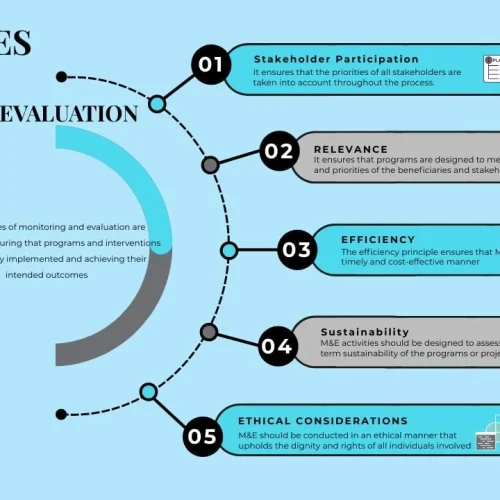In a world grappling with complex challenges—from climate change and health crises to education inequality and governance deficits—the question is no longer whether to act, but how to act effectively. As governments, organizations, and communities invest billions in development initiatives, one critical tool emerges as a beacon of accountability and progress: Monitoring and Evaluation (M&E).
M&E, once perceived as an administrative afterthought, is now at the forefront of sustainable development. It serves not just as a mechanism for tracking progress but as the very engine that drives impactful, evidence-based interventions.
Why M&E Matters: Beyond Numbers and Reports
Sustainable development is not a one-size-fits-all endeavor. What works in one region or community may fail in another. Monitoring and Evaluation bridge this gap by offering a tailored approach to problem-solving, ensuring that resources are utilized where they matter most.
Take Uganda, for instance. Over the last decade, the country has made strides in areas like education access and maternal health. Yet, persistent challenges such as rural poverty and youth unemployment demand innovative approaches. Here, M&E steps in—not as a bureaucratic hurdle but as a compass guiding decision-makers toward scalable, impactful solutions.
M&E: A Framework for Accountability
Imagine a school feeding program in rural Africa designed to increase attendance. Without M&E, how would we know if the meals provided are translating into better enrollment and learning outcomes? M&E transforms such initiatives from assumptions into evidence-backed successes.
- Tracking Progress: M&E systems provide a roadmap for development programs, from inception to execution. Milestones are set, outcomes are measured, and challenges are identified in real time.
- Ensuring Accountability: With donor funding often under scrutiny, M&E offers transparency by demonstrating how funds are used and their resulting impact.
- Promoting Learning: Failures are not the enemy of development—complacency is. By learning from setbacks, organizations refine their strategies and maximize future impact.
The Human Story Behind M&E
Beyond the charts and dashboards are stories of transformation. One such story is that of Sarah, a farmer in northern Uganda who benefited from an agricultural capacity-building program supported by IDEAS Limited. The program initially aimed to train 1,000 farmers in sustainable practices, but M&E revealed that cultural barriers were limiting women’s participation. Armed with this insight, the program adjusted its approach, integrating female-specific training sessions and mentorship opportunities. The result? Not only did the program exceed its target, but women like Sarah are now leaders in their communities, championing sustainable farming practices.
M&E in Action: Uganda’s Road to Progress
Uganda’s development journey illustrates the power of M&E across sectors:
- Healthcare: IDEAS partnered with international organizations to monitor maternal health interventions in rural regions. M&E revealed gaps in antenatal care access, leading to targeted mobile health clinics and a marked decrease in maternal mortality.
- Education: Through systematic evaluation, IDEAS identified critical bottlenecks in girls’ education, such as inadequate sanitation facilities and early marriage. This data informed policies and projects that increased enrollment and retention rates.
- Youth Empowerment: IDEAS used M&E to track the effectiveness of entrepreneurship programs for unemployed youth. The findings shaped the design of future initiatives, focusing on mentorship and market linkages for sustainable employment.
The Global Perspective: M&E and the Sustainable Development Goals (SDGs)
The 17 SDGs adopted by the United Nations represent humanity’s collective ambition for a better future. Yet, achieving these goals is impossible without robust M&E frameworks. Each SDG, from eradicating hunger to ensuring gender equality, requires continuous measurement to gauge progress and adjust strategies.
For developing nations like Uganda, M&E is the linchpin in aligning national priorities with global objectives. By identifying gaps and leveraging local insights, Uganda is not just a participant in the SDG journey—it is a model for how data-driven decision-making can drive meaningful change.
Challenges in M&E: The Roadblocks
Despite its potential, M&E faces significant hurdles:
- Resource Constraints: Effective M&E systems require investment in training, technology, and manpower, which can be a barrier for low-income regions.
- Data Reliability: Inconsistent data collection methods or biases can undermine the accuracy of evaluations.
- Resistance to Change: Organizations may hesitate to adapt based on M&E findings, fearing short-term disruptions despite long-term benefits.
Overcoming these challenges requires a shift in mindset, where M&E is seen not as a cost but as an investment in success.
The Future of M&E: Innovation and Technology
As technology evolves, so does the potential of M&E. Mobile data collection, artificial intelligence, and geospatial mapping are revolutionizing how data is gathered and analyzed. These innovations enable real-time insights, ensuring that interventions are adaptive and responsive.
For Uganda, integrating technology into M&E means faster, more accurate decision-making. Imagine a health program using drones to deliver vaccines to remote areas while simultaneously using GPS data to evaluate coverage gaps. This is not just the future of M&E—it’s the future of sustainable development.
Conclusion: A Call to Action
Monitoring and Evaluation are no longer optional—they are essential. They are the pulse check of progress, the safeguard of accountability, and the spark for innovation. In Uganda and beyond, M&E transforms ambitions into achievements, ensuring that every dollar spent, every program launched, and every promise made leaves a lasting legacy.
As we look to the future, the role of M&E in sustainable development is clear: to illuminate the path forward, adapt to the challenges ahead, and empower communities to take ownership of their destiny.
CTA: “Discover how IDEAS is using M&E to drive impactful change. Contact Us to learn more or partner with us on your next initiative.”







